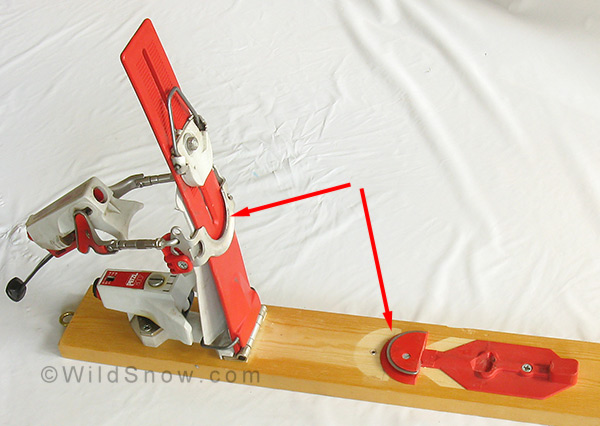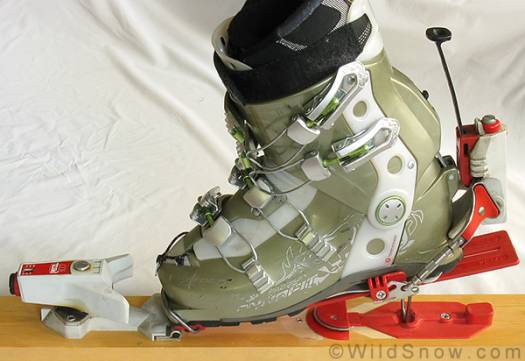No other ski touring binding of the mid 1980s and early 1990s was as “alpine like” as the Petzl (later renamed Sk’Alp). The toe is a conventional (for that era) Salomon 447 alpine unit. The heel is not step-in (that would come later, see below), though it is easy to operate, with DIN settings and vertical elasticity akin to any other alpine unit of the day. Through an ingenious use of a sliding catch system, the binding was essentially two in one.
For alpine mode, you insert your boot toe in the conventional toe unit and over-center pivot heel clamp. To tour you slid the heel clamp back, insert your toe in a wire bale, and thus have a walking binding.
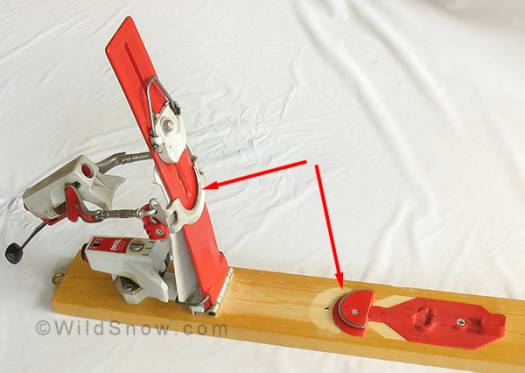
Binding plate raised on touring pivot, showing underside. Arrows indicate half-moon shaped mechanism that engaged to lock the plate down for alpine (latched heel) mode. Conversion between modes requires exiting the binding. V shaped wire near top is the climbing lifter, engaged by flipping down.
In terms of release safety, the excellent feature of this design is that the binding heel unit is on a “turntable” while in alpine mode, thus allowing your foot to rotate smoothly to the side when a toe release is necessary. Anti friction features of the Petzl are also first-rate, as the boot sole rides on a full length anti friction plate system when the binding is mounted and adjusted correctly.
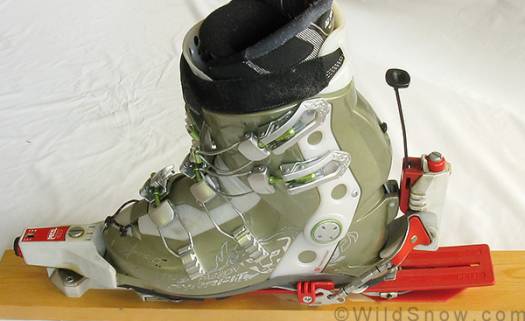
Petzl binding in alpine mode. Similarity to conventional alpine bindings of this era is obvious, and was appreciated by users concerned with the downhill performance of other randonnee bindings.
To convert to touring, you exit the binding, disengage the heel unit from the half-moon shaped catch, then slide the heel unit back on the red plate/track so the boot has room to fit in the toe wire as shown above.
Sometime in the early 1990s the heel was changed to a step-in unit sourced from Look. Soon after that the name was changed to “Sk’Alp.” (We’re still looking for this version of the binding, if anyone has one they’d like to contribute please contact us.)
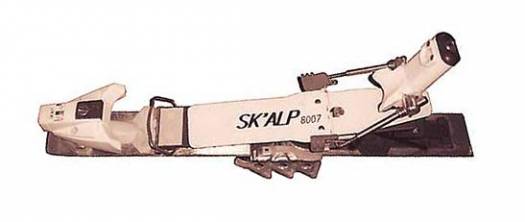
Skialp (Petzl) binding with crampon.
Binding shown above has crampon that attaches via the half-moon shaped catch used for latching the plate down in alpine mode. This crampon system became the favored aftermarket crampon of the day and worked well with just about any touring setup, including telemark gear. You’d simply mount the half-moon shaped fitting on your ski, and the crampon was easy to snap on and off. Sadly, the Sk’Alp crampon has a max dimension of about 80 mm, so they don’t work with many wider modern skis.
Dick Jackson (owner of Aspen Expeditions) imported the Petzl models for many years. He first imported a black plastic model in 1985, and told me the original design/model had a metal plate and probably dates back to the early 1980s, making this one of the longer running designs in randonnee binding history.
In all, the Petzl and Sk’Alp binding models pioneered the way for today’s alpine-like backcountry skiing bindings such as Fritschi and Marker, which in turn revolutionized modern ski alpinism.
Weight (one binding with screws): 31.8 oz, 900 gr

Petzl binding thumbnail.

